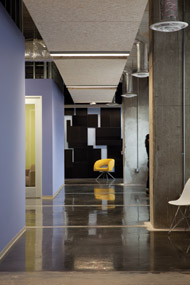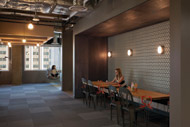| COVER STORY, MARCH 2012
AFTER THE RECESSION
Architects and contractors expect an uptick in activity in 2012.
John Nelson
The construction market has not been kind to its stewards — architectural firms and general contractors — in recent years. The production of commercial buildings in Texas has slowed from its height during the commercial boom of the mid-to-late 2000s to a dribble from 2008 to 2011. While most commercial real estate professionals concede that there won’t be a dramatic increase in new construction this year, they expect an uptick in activity nonetheless.
“There’s a little more optimism than last year. Is (activity) going to be huge? Probably not,” says Neal Harper, president of Cadence McShane Construction Co., a Dallas-based contractor. “We’re looking at our forecasts, and we’ve already signed up more work than what we had at this point last year.”
The American Institute of Architects’ (AIA) Architecture Billings Index (ABI), a figure derived from a monthly survey conducted by the AIA Economics & Market Research Group, has most recently posted a score of 51 in January, the same score as the previous month.
“A score of 50 or above is indicative of recovery,” explains Don Powell, founding principal at BOKA Powell, a commercial design firm based in Dallas. “We will get confident when we see indices of 55 or 60.”
The score is significant because the index has now posted a score above 50 for 3 months in a row. The index is an economic litmus test for commercial construction activity. According to AIA, the index indicates construction activity 9 to 12 months down the road. The industry can also look at architects’ workload as an indicator of future construction activity.
“Architects normally get busy 6 months ahead of the construction industry,” says Powell. “We’re a great indicator for recovery and growth, but we have seen mixed signals.”
OBSTACLES TO
OVERCOME
Since 2008, architectural firms and contractors have had an uphill climb just to stay afloat. Several firms folded during this period while others experienced massive layoffs and consolidation.
The end result has been an influx of former employees of architectural and contracting firms into the market who have started their own practices. Coupled with that, far less work has come through the pipeline, so there is less work to go around but more competitors in the arena.
Brigitte Preston, design principal and co-owner at lauckgroup, a commercial interior design firm with offices in Dallas and Austin, remembers a particular project in Texas at the height of the recession. “We submitted credentials for a university project and there were 60 other firms bidding for that same work,” recalls Preston. “There just wasn’t enough work to go around.”
The increased competition has been stifling for firms that now have to battle underbidding and an inherent decrease in the number of projects. Many firms have had to cut costs and staff because the workload doesn’t support their overhead costs. Tommy Burt, president and co-founder of Burt-Watts Inc., an Austin-based general contracting and construction management firm, describes the rising tide of competitors as unavoidable.
“There is no escaping the competition,” says Burt. “Every facet of our industry has been affected by increased competition.”
For firms to be tapped to design or construct a project, they have to price their services competitively. Pricing that is too low leads to less revenue, which really has put design and construction firms in a bind.
“(Competition) drives the margins down. It’s just hard. You’ve got to keep your business alive so you have to be competitive on the pricing side because that’s one of the largest factors in the selection process,” explains Harper.
The recession and slow recovery have complicated matters further because lending standards have tightened considerably, especially for new construction. While beneficial to a certain extent — tighter underwriting standards lead to quality loans — developers find it stressful to meet higher-equity requirements.
“(Financial institutions) are still very critical of real estate projects. It’s still difficult, even with good preleasing, to get good equity in the projects,” says Van Martin, chairman and CEO of Tribble & Stephens, a construction management firm based in Houston. “We’re seeing good projects still having a tough time getting past bank regulations and getting funding because the banks are under pressure from bank regulators.”
Harper continues, “You used to be able to finance 90 percent of a project. Depending on what the project is now, you may be able to finance 60 percent and have 40 percent equity.”
Many projects have stalled or have been scrapped because of the lack of debt provided by lenders and the lack of equity from developers or tenants. Some companies that fared well through the recession are still sitting on their cash until the market improves, according to Harper.
ADAPT OR DIE
The intense competition for relatively few projects combined with the struggle to procure debt and equity for projects have crippled some design and contracting firms and put plenty out of business. These seemingly indelible obstacles have also presented opportunities for these firms, thanks in part to an improved climate for lenders.
According to a survey conducted by Texas Real Estate Business, 86.4 percent of lenders expect to dole out more capital for projects in 2012 than in 2011. Of those that expect an increase, a majority anticipate the lending volume to grow by 20 percent.
“Lenders will be conservative, but active. Equity will be available for well-sponsored, well-located deals,” said one participant in the write-in portion of the survey.
Financing projects has been a struggle for construction projects, but industry professionals are noticing that some lenders are loosening their purse strings. Harper attributes the improving lending atmosphere to banks and financial institutions moving past the aftermath of consolidation, mergers and acquisition. Lenders are starting to figure out what loans they’re working with and the quality of those holdings.
“Banks are working with better information now because they’ve had time to deal with the bad loans,” says Harper. “Hopefully, now their valuations are better.”
Cash-rich companies are also getting off the sidelines and investing more into commercial real estate projects. Increasing equity has helped commercial projects get off the ground.
“Corporate America is starting to spend some of the money it’s been sitting on,” says Martin.
The decrease of available work is another heartbreaker for many firms, and companies need to be active to combat shutting their doors. Richard Weiss, founder of Weiss Architecture Inc., a commercial and residential architectural firm based in Austin, took a proactive approach during the downturn.
“We were in constant contact with our clients and trying to get as much help as we could,” says Weiss. “We had eyes on the street where we would be looking for properties, or if we drove by a location that was vacant we’d call our clients and let them know this space is vacant. We were trying to create work.”
Most firms that survived the recession had to
adapt to the marketplace by diversifying their skill set. Companies like BOKA Powell have had to stray from their bread-and-butter projects in order to stay profitable.
“We intentionally shifted our focus away from high-rise office buildings as a major source of revenue. Healthcare, hospitality, higher education and urban housing are all good markets for us,” says Powell. “Seeking recession-proof opportunities and diverse sources of revenue are critical.”
Harper says that Cadence McShane also had to diversify its portfolio to keep in touch with the projects in demand. “We have diversified because if any one of those particular markets falls off the edge of the cliff, we don’t want to be falling with it,” says Harper.
Building-type diversity has helped firms to differentiate themselves from their competitors. The increased competition has also forced firms to rely on different aspects of their established business.
Cadence McShane is a bonded contractor, which is an asset because all civic projects such as schools and libraries require the property owner or user to take a bond out on the contractor.
“Bonding has been a plus for us, that’s been an opportunity because we had been pretty strong financially. We can provide bonds whereas other construction companies can’t,” explains Harper.
 |
The Facebook offices in Austin were designed by lauckgroup during the height of the downturn in October 2010. The interior design firm relied on its high standards to push through increased competition and a decreased workload. |
|
Architectural firms like lauckgroup have relied on their established design standards to help them win bids for projects. The firm’s past designs and adherence to quality work helped them land the contract for Facebook’s Austin office project, which was delivered in the midst of the recession in October 2010.
“If you read about any firm in any industry, they have fared better if they maintained a quality product,” says Preston. “Since we offer a higher level of service and high level of design, we’ve been able to maintain a lot of client relationships and thrive.”
A firm’s portfolio is crucial to win bids for new contracts because companies need assurance that a firm can deliver their projects. Robert Clay, owner of Clay Development & Construction Inc., an industrial contractor based in Houston, relies on the company’s familiarity of the product type and its in-house design team to win bids.
“We sell our story a lot more than we used to,” says Clay. “It’s always been about price, but now I can go in and sell the company and say we’ve built x number of buildings and we do everything in-house.”
The ability to have a design pitch ready in days instead of weeks has helped Clay Development garner projects. Other firms, like Weiss Architecture, benefitted from its general makeup.
 |
The Facebook offices in Austin were designed by lauckgroup in October 2010. “If you read about any firm in any industry, they have fared better if they maintained a quality product,” explains Brigitte Preston, design principal and co-owner at lauckgroup, on the importance of quality during a downturn. |
|
“Being a small firm is the best position we could be in because we don’t have a lot of overhead or big salaries or big rents,” says Weiss. “We’ve always kept it small and that allowed us to adjust with the economy.”
The harsh economic downturn provided opportunities to firms like Weiss Architecture that have relationships with property owners from years of being in the business. There is a particular property in Austin that had several tenants come through it and eventually close up shop. Weiss Architecture had designed the property for one of the tenants and benefitted from the relationship it had with the owner.
“The owner would recommend us to whoever was next,” says Weiss. “It wasn’t good for our clients, but it provided us with an opportunity.”
For this year, industry professionals expect much less of a survival level of activity and for the gates to open more.
“We’ve actually seen a pick up of activity,” continues Martin. “We’ve seen more projects starting to come up again.”
In the owner/developer survey Texas Real Estate Business conducted, 72 percent of participants felt confident that their respective firms would have more business in 2012 than in 2011. For a detailed list of recently-completed projects or ones in development, turn to our Property Lines section on page 13.
“Our work load was up 20 percent in 2011 compared to 2010,” says Preston. “When I look at the backlog for this year and the kind of activity we’ve had in the last couple of weeks, I think we’re going to be up again this year.”
©2012 France Publications, Inc. Duplication
or reproduction of this article not permitted without authorization
from France Publications, Inc. For information on reprints of
this article contact Barbara
Sherer at (630) 554-6054.
|
